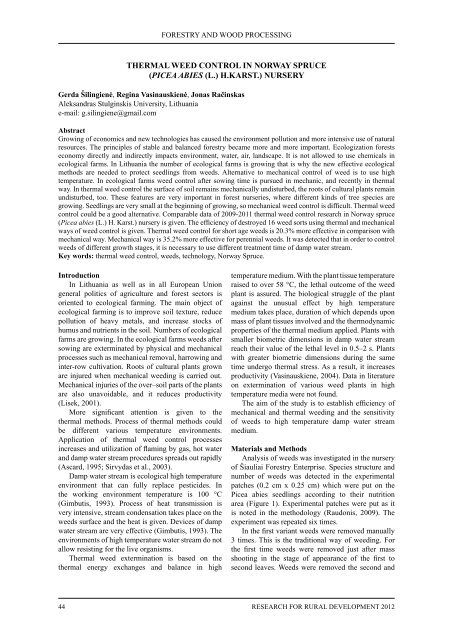RESEARCH FOR
RESEARCH FOR
RESEARCH FOR
You also want an ePaper? Increase the reach of your titles
YUMPU automatically turns print PDFs into web optimized ePapers that Google loves.
tHermal Weed control In norWay spruce<br />
(PICEA ABIES (l.) H.Karst.) nursery<br />
Gerda Šilingienė, Regina Vasinauskienė, Jonas Račinskas<br />
Aleksandras Stulginskis University, Lithuania<br />
e-mail: g.silingiene@gmail.com<br />
abstract<br />
Growing of economics and new technologies has caused the environment pollution and more intensive use of natural<br />
resources. The principles of stable and balanced forestry became more and more important. Ecologization forests<br />
economy directly and indirectly impacts environment, water, air, landscape. It is not allowed to use chemicals in<br />
ecological farms. In Lithuania the number of ecological farms is growing that is why the new effective ecological<br />
methods are needed to protect seedlings from weeds. Alternative to mechanical control of weed is to use high<br />
temperature. In ecological farms weed control after sowing time is pursued in mechanic, and recently in thermal<br />
way. In thermal weed control the surface of soil remains mechanically undisturbed, the roots of cultural plants remain<br />
undisturbed, too. These features are very important in forest nurseries, where different kinds of tree species are<br />
growing. Seedlings are very small at the beginning of growing, so mechanical weed control is difficult. Thermal weed<br />
control could be a good alternative. Comparable data of 2009-2011 thermal weed control research in Norway spruce<br />
(Picea abies (L.) H. Karst.) nursery is given. The efficiency of destroyed 16 weed sorts using thermal and mechanical<br />
ways of weed control is given. Thermal weed control for short age weeds is 20.3% more effective in comparison with<br />
mechanical way. Mechanical way is 35.2% more effective for perennial weeds. It was detected that in order to control<br />
weeds of different growth stages, it is necessary to use different treatment time of damp water stream.<br />
Key words: thermal weed control, weeds, technology, Norway Spruce.<br />
Introduction<br />
In Lithuania as well as in all European Union<br />
general politics of agriculture and forest sectors is<br />
oriented to ecological farming. The main object of<br />
ecological farming is to improve soil texture, reduce<br />
pollution of heavy metals, and increase stocks of<br />
humus and nutrients in the soil. Numbers of ecological<br />
farms are growing. In the ecological farms weeds after<br />
sowing are exterminated by physical and mechanical<br />
processes such as mechanical removal, harrowing and<br />
inter-row cultivation. Roots of cultural plants grown<br />
are injured when mechanical weeding is carried out.<br />
Mechanical injuries of the over–soil parts of the plants<br />
are also unavoidable, and it reduces productivity<br />
(Lisek, 2001).<br />
More significant attention is given to the<br />
thermal methods. Process of thermal methods could<br />
be different various temperature environments.<br />
Application of thermal weed control processes<br />
increases and utilization of flaming by gas, hot water<br />
and damp water stream procedures spreads out rapidly<br />
(Ascard, 1995; Sirvydas et al., 2003).<br />
Damp water stream is ecological high temperature<br />
environment that can fully replace pesticides. In<br />
the working environment temperature is 100 °C<br />
(Gimbutis, 1993). Process of heat transmission is<br />
very intensive, stream condensation takes place on the<br />
weeds surface and the heat is given. Devices of damp<br />
water stream are very effective (Gimbutis, 1993). The<br />
environments of high temperature water stream do not<br />
allow resisting for the live organisms.<br />
Thermal weed extermination is based on the<br />
thermal energy exchanges and balance in high<br />
<strong>FOR</strong>ESTRY AND WOOD PROCESSING<br />
temperature medium. With the plant tissue temperature<br />
raised to over 58 °C, the lethal outcome of the weed<br />
plant is assured. The biological struggle of the plant<br />
against the unusual effect by high temperature<br />
medium takes place, duration of which depends upon<br />
mass of plant tissues involved and the thermodynamic<br />
properties of the thermal medium applied. Plants with<br />
smaller biometric dimensions in damp water stream<br />
reach their value of the lethal level in 0.5–2 s. Plants<br />
with greater biometric dimensions during the same<br />
time undergo thermal stress. As a result, it increases<br />
productivity (Vasinauskiene, 2004). Data in literature<br />
on extermination of various weed plants in high<br />
temperature media were not found.<br />
The aim of the study is to establish efficiency of<br />
mechanical and thermal weeding and the sensitivity<br />
of weeds to high temperature damp water stream<br />
medium.<br />
materials and methods<br />
Analysis of weeds was investigated in the nursery<br />
of Šiauliai Forestry Enterprise. Species structure and<br />
number of weeds was detected in the experimental<br />
patches (0.2 cm x 0.25 cm) which were put on the<br />
Picea abies seedlings according to their nutrition<br />
area (Figure 1). Experimental patches were put as it<br />
is noted in the methodology (Raudonis, 2009). The<br />
experiment was repeated six times.<br />
In the first variant weeds were removed manually<br />
3 times. This is the traditional way of weeding. For<br />
the first time weeds were removed just after mass<br />
shooting in the stage of appearance of the first to<br />
second leaves. Weeds were removed the second and<br />
44 ReseaRch foR RuRal Development 2012


